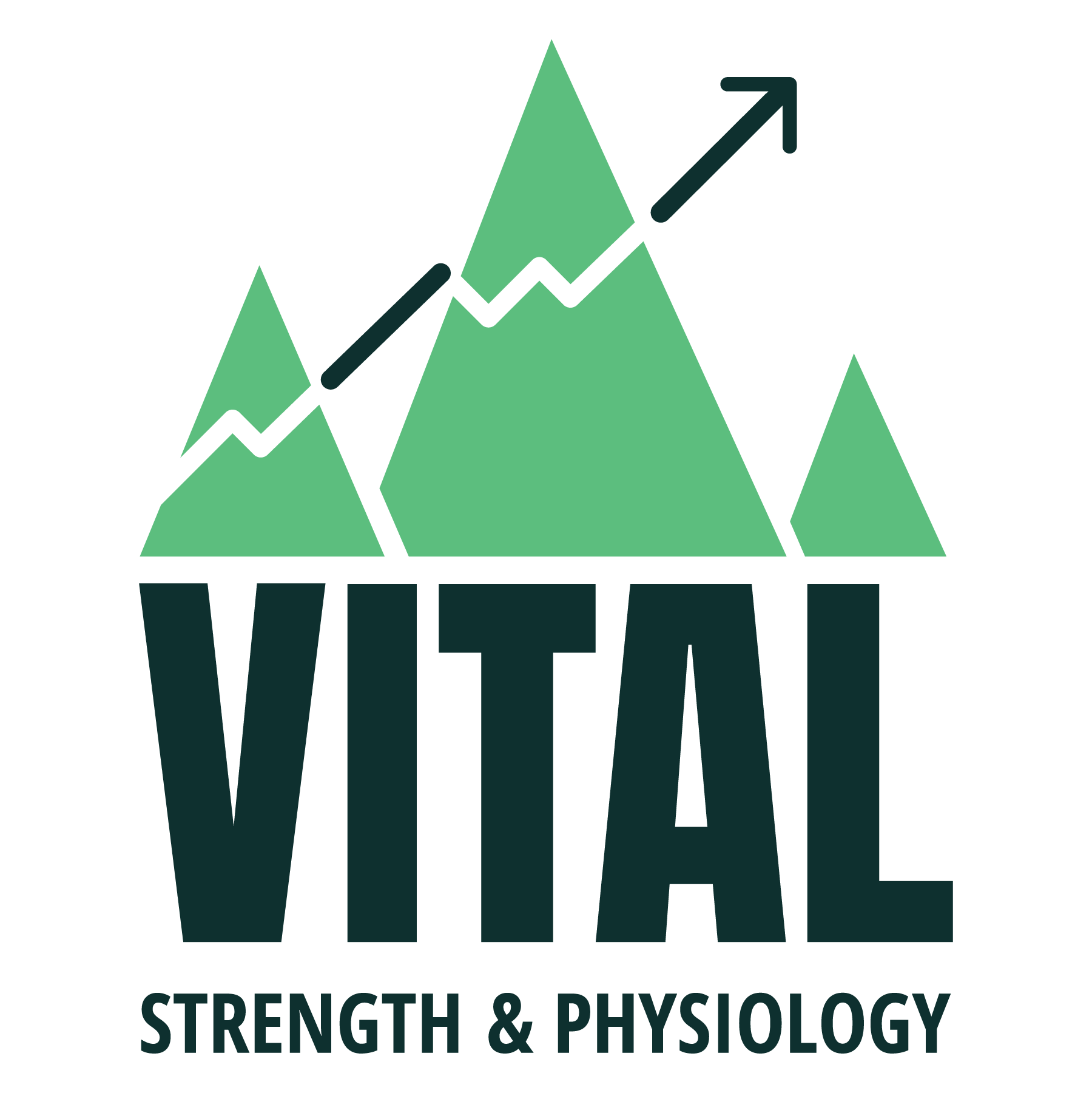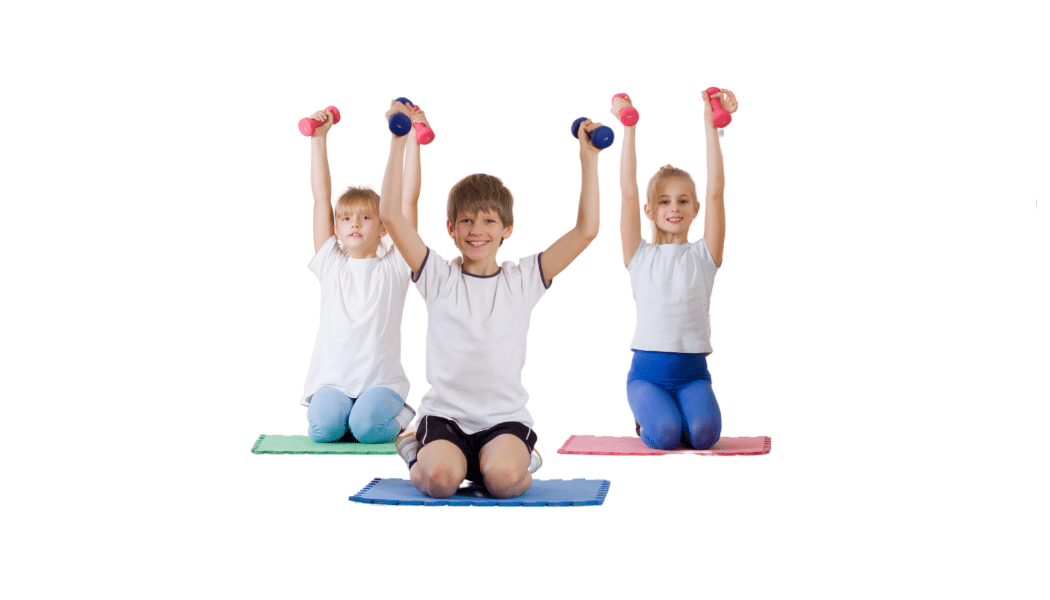Why are children and teens lifting weights nowadays?
Participation in organized youth sports is increasing and opportunities to participate in competitive environments are happening at younger ages. Not only are kids starting sport at younger ages, they are also doing sports for more months of the year… and this is becoming more and more prominent in all sports. This increase in year-round sport participation has fostered a concomitant growth in the strength and conditioning industry, with efforts to enhance performance and prevent injuries. Notably, these recent changes have led many parents to ask the valid questions,
“Is it safe for my kid to lift weights?”
“When is the best age for them to start?”
“Who should I trust their training with?”
“SHOULD MY CHILD OR TEEN BE LIFTING WEIGHTS?”
Clearly, it’s invaluable to know how and when to begin strength training and weight lifting programs in youth; especially if it is detrimental too young or past the point of being beneficial if introduced too late. So, is it beneficial to start young? Is it detrimental to start late? Let’s review some of the evidence.
How is weight training defined?
Weight-training programs may be designed to improve muscular strength and endurance through the application of progressive overload. Progressive overload is the training principle that states that the body needs progressively greater demands placed on it for training adaptations to take place, like strength and fitness increases.
For the purpose of this article, strength training (or resistance training) will refer to a special method of conditioning used to increase ability to exert force or resist force. This should be distinguished from weightlifting and powerlifting which is reserved to describe high intensity techniques used to lift maximal amounts of weights. Additionally, it is important to distinguish between children (pre-pubescent; up to age 11 girls and 13 boys), and adolescents (typically girls aged 12 to 18 and boys aged 14 to 18) in that the transition from one to the other has a relatively large range. Whether or not your child should lift weights depends LESS on their age and MORE on their development and whether or not they have hit puberty or their growth spurt. More on this later.
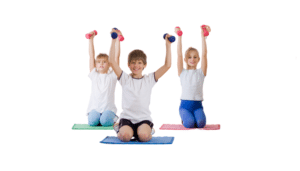
Are there benefits to children doing this type of training?
Positive training outcomes associated with weightlifting include increased bone mineral density, motor pattern learning, increased muscle mass, decreased fat mass, and injury prevention. Wow – it sounds initially like lifting weights for children is super beneficial!
Although it is practiced safely and with positive and beneficial outcomes for healthy adults, then why, at times, has it been advised against in children?
Weight-training was thought to be harmful to children and adolescents due to potential risks of injury which may include damage to bones (i.e., growth plates) which may result in premature closure of growth plates and discrepancies in limb length. In young boys, it was believed that a lack of circulating androgenic hormones (i.e., testosterone) would not permit improvements in strength. However, there is evidence to suggest increases in force generating capacity is primarily a neuromuscular adaptation that is not dependent on muscle size, even in prepubescent children. In other words, you get your brain to fire to the muscle better and achieve better coordination, rather than lifting weights being ALL about gaining muscle.
Are children even capable of gaining strength?
A multitude of studies have been conducted on the effects of strength training in children. In a study by Ramsay (1990), thirteen boys (age 9-11) participated in a 20-week resistance training program three times per week. Significant improvements in 1-RM (1 rep max) bench press, leg press, isometric elbow flexion, knee extension strength was observed. The overarching conclusions across these studies suggest that various training modes such as weight machines, free- weights, body weight, sport-conditioning drills and even various sets and reps provide adequate stimuli for strength enhancement in youth (Faigenbaum, 2000).
As such, participation in any form of resistance exercise is far better than not participating at all. When examining the safety of weight training programs in children, a review by Faigenbaum (2000), found no greater incidence of injury in training groups compared to the control groups. Correspondingly, inadequate levels of circulating androgens (hormones) attenuated increases in cross-sectional area, so mechanisms of strength gains appeared to be related to neurological learning effects rather than hypertrophy (increase in the cross-sectional area of muscle) (Bernhardt, 2000).
This would suggest that “resistance training” per se could not only be beneficial, but it could be VERY beneficial, even if started at young ages!
There is a misconception that resistance training is all about barbells and dumbbells – but that is not true. Resistance training in the early stages involves learning movement patterns and coordination, and light resistance before the youth can progressively overload the patterns with more load or volume.
Both participation in resistance training AND exposure to different sports are important – and resistance training can act to help develop youth athletes in a more well-rounded way, changing up the areas of the body that are loaded, and helping to prevent repetitive injuries associated with certain sports.
There is a massive misconception that the participation in resistance exercise is purely to put on muscle. But, the activation of muscle groups, increasing the mind-muscle connection, movement pattern development such as when performing deadlifts and squats, will only benefit the young athlete when the coaches are trained in appropriate starting points for the lifts and appropriate rates of overload for children and youth. This position statement is reflected in the Long Term Athletic Development (LTAD) model by Balyi (2003). “How young is too young?” is likely a question about the ability of the child to be stay focused and be motivated to try new movement skills involved in strength training and conditioning.
I’ve heard it can stunt children’s growth
Strength training or lifting weights does not appear to have negative implications for muscular adaptations in children, however, the stunting of growth has been raised as a fear of strength training in children in the past (Kröger, Kotaniemi, Kröger, & Alhava, 1993). At the onset of puberty, ossification overruns the growth plate, fusing the primary growth centre to the secondary growth centres, resulting in a mostly unchanged length of bone thereafter (Mackie, Ahmed, Tatarczuch, Chen, & Mirams, 2008). But, contrary to the belief that “strength training” could negatively affect childhood development, no evidence directly supports the claim that resistance training would cease the growing of children’s growth plates (Guy & Micheli, 2001).
While everyone knows someone who’s kid has been injured playing sports, lifting weights, and learning new movement patterns should actually be a very controlled, progressive, and safe way to load the muscles, tendons and, bones (unlike the chaos that comes with some sports). In fact, dynamic exercise, especially resistance training, has been shown to have clear benefits for the skeleton – like increased strength of bones, and long-lasting effects of these changes.
When youth lift weights – does it benefit them as adults?
Studies examining the bone mineral content (BMC) of competitive tennis and squash players, have shown that the dominant arm used to hold the racket not only had much higher BMC than the non-dominant arm, but also that this difference is observed significantly more pre-puberty than in adults. This. is extremely important because it means that loading more bones in the body, in more varied and progressively harder ways, BEFORE PUBERTY can help us maintain bone mass into adulthood. Osteoporosis is a massive health burden in old age, and this could minimize that problem to. an extent.
Is loading bone a good thing? Well, when mechanical compressions of the ulna was evaluated in rodent models over 16 weeks, tests revealed that bone mineral density (BMD) and content improved by 5-6%, yet there was a 64% increase in ultimate force (i.e., maximal amount of force the bone could support before failing) and a 94% increase in energy failure (i.e., amount of energy absorbed by the bone before failure). This means – bones were more resistant to BREAKS!
Interestingly, mechanical loading was found to be more effective if loads were applied in small bouts separated by recovery periods rather than if large loads were applied in a single session. So, repetition is key! Although this study was done on rats, this information can be translated to humans as bone formation and adaptations occur via similar mechanisms.
Importantly, engaging in exercise during skeletal growth is shown to be more beneficial than exercise after skeletal maturation (post-puberty), so loading children’s bones during times of growth, even without the corresponding large increases in muscles that we typically associate with “strength training”, could result in long term bone health implications!
When is the best age to start?
How should we know what age to transition children and adolescents into weight training? Chronological and developmental ages can vary drastically in that two twelve-year-olds could be the same age, but in completely different stages of development of bone and puberty. It appears that peak bone mineral density occurs around menarche (menstruation) in females (around age 12) and around ages 13-17 in males (adolescence) (Kröger et al., 1993), which is typically right after peak height velocity (PHV) occurs.
PHV landmarks the start of the growth spurt and peak of the spurt, and they are key landmarks for design of training and competition programs. Soon after PHV, the growth plates will fuse, and this appears to be the best time to build muscular strength due to its sensitive period, outlined in the LTAD model, occurring 1-2 years after. This would be the optimal time to start building muscular strength because not only is the bone fully fused, but it has also reached its full potential for growth.
How do you know if your kid has hit peak height velocity? Keep track of their height over time, graph it, and you will see something like this:
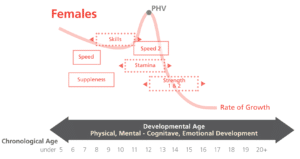
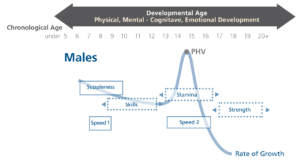
(Retrieved from the Long Term Athlete Development Model 2.0)
What would these early stages of training look like?
Here’s a short example of some of the exercises we might include in a session for a 12 and 14 year who are learning more movement-based training, as opposed to training just to “lift weights”:
From ages 0-6, the recommendations are to have kids start general exploration of movement, on all environments and surfaces (ice, snow, gravel, grass, water). Structured gymnastics and swimming programs usually begin this young.
Between the ages of 6-9, depending on the child’s mental cognitive and emotion development, we can start introducing the ABC’s of athleticism (agility, balance, coordination, and speed) (Balyi, 2006). This would also be an appropriate time to start doing body weight exercises and slightly more structured programs.
Between the ages of 8-12, Balyi (2006) recommends that we should further introduce resistance training, for example through body weight, medicine ball, and swiss ball exercises to progressively overload the developing sport patterns and movement skills. Between 11-16, most children will hit puberty, and attain their PHV, where introducing free weights to continue the progressive overload would be appropriate (Balyi, 2006).
Where should you start?
The Canadian Society for Exercise Physiology’s (CSEP) recommendations for resistance training in youth and adolescents include low- to moderate-intensity resistance exercise 2–3 times a week on non-consecutive days, with 1–2 sets initially, progressing to 4 sets of 8–15 repetitions for 8–12 exercises.
They recommend that exercises including more advanced movements such as Olympic-style lifting, plyometrics, and balance training, which can enhance strength, power, co-ordination, and balance, should be used with gradual progression under qualified instruction and supervision with appropriately sized equipment. Resistance training can safely lead to functional (i.e., muscular strength, endurance, power, balance, and co-ordination) and health benefits in these populations (Behm et al., 2008).
If you’re looking for training ideas for your kid and aren’t ready to make the financial and time commitment to hire a trainer, a great place to start is YouTube. We love the videos this content-creator, “Get Kids Moving” creates which involve super-hero workouts based on body weight exercises. The graphics and short workouts could be a great start for kids.
For teenagers, depending on the sport and their skill and fitness level, hiring a skilled strength and conditioning professional with a certification like CSCS, CSCA, CSEP, or CPT might be a great place to start. Check their references, ask them hard questions, and interview other parents of teens they train before committing.
Summary
In conclusion, recommendations for strength training for children are to start with physical literacy and to let kids play as much as possible as often as possible while experiencing different planes of movement, upper and lower extremities, and different surfaces (ice, snow, gravel, grass, water). The goal here is to develop the neuromuscular system for a strong base of coordination as well as to enhance bone and cardiovascular development.
The more fun a kid has with their “training”, in other words – how well we can disguise “training” as play – the more likely they will continue participating in the activity, even in the long term. As per the LTAD model, it is advantageous to cash in on the sensitive periods of trainability.
Strength improvements are prominent after PHV (peak height velocity) is passed, because bones are at their peak lengths, are strong, and newly circulating hormones help develop the muscles as well as help lay down a protective layer of BMD during that sensitive period. Long term considerations of the LTAD model, although it is not completely evidence-based and is not an individualized approach, presents an advancement in the understanding of the developing athlete alongside their biological growth.
If possible, improvements in sports systems would allow grouping of athletes according to developmental age rather than chronological age, and if this criterion could not be adapted to, then better alignment of strength and conditioning programs with growth could be a future solution. An easy fix for this is hiring someone to work with your kid or teenager in a 1-1 or small group setting (like how we operate!) to ensure they are progressing appropriately and according to their ability.
The take-home message is that resistance training in youth is safe and effective, and it can have many health-related benefits. Furthermore, the safety and effectiveness of training will be maximized under the supervision of a qualified strength and conditioning coach.
So, yes, it is safe for youth and children to lift weights, when introduced in a safe, progressive, and movement pattern focused way!
Send this to a friend who might have these same questions on their mind!
References
Baechle TR, Earle RW. (Eds.). (2000). Essentials of Strength Training and Conditioning (2nd ed.). Champaign, IL: Human Kinetics
Balyi, I., Way, R., Higgs, C., Norris, S., Cardinal, C. (2006). Long-Term Athlete Development 2.0: Canadian sport for life. Canadian Sport Institute. Retrieved from https://scholar.google.com/scholar?hl=en&btnG=Search&q=intitle:Canadian+sport+for+life#6
Bijeh, N., & Shahrabadi, H. (2018). Resistance Training in Immature Children: A Review Article. 3(1), 38–45. https://doi.org/10.30468/JBIOM.2018.63143
Behm, D. G., Faigenbaum, A. D., Falk, B., & Klentrou, P. (2008). Canadian Society for Exercise Physiology position paper: resistance training in children and adolescents. Applied Physiology, Nutrition, and Metabolism, 33(3), 547–561. doi:10.1139/H08-020
Bernhardt, D. (2000). Strength Training by children and adolescents. Journal of Pediatrics, 107(6), 1470–1472.
Bonjour, J. P., Theintz, G., B. (1991). Critical years and stages of puberty for spinal and femoral bone mass accumulation during adolescense. Journal of Clinical Endocrinology, 73(3), 555–563.
Canadian Sport for Life. (2014). Canadian Sport for Life: Long Term Athlete Development 2.0.
Faigenbaum, A. D. (2000). Strength training for children and adolescents. Clinics in Sports Medicine, 19(4), 593–619.
Ford, P., De Ste Croix, M., Lloyd, R., Meyers, R., Moosavi, M., Oliver, J., … Williams, C. (2011). The long-term athlete development model: physiological evidence and application. Journal of Sports Sciences, 29(February 2015), 389–402. doi:10.1080/02640414.2010.536849
Guy, J. a, & Micheli, L. J. (2001). Strength training for children and adolescents. The Journal of the American Academy of Orthopaedic Surgeons, 9(1), 29–36.
Haapasalo, H., Kannus, P., Sievänen, H., Pasanen, M., Uusi-Rasi, K., Heinonen, a, … Vuori, I. (1998). Effect of long-term unilateral activity on bone mineral density of female junior tennis players. Journal of Bone and Mineral Research : The Official Journal of the American Society for Bone and Mineral Research, 13(2), 310–319. doi:10.1359/jbmr.1998.13.2.310
Hert, J., Landa, J. (1971). Reaction of bone to mechanical stimuli. Continuous and intermittent loading of tibia in rabbit. Folia Morphologica : Pracha, 19, 290–300.
Kröger, H., Kotaniemi, a, Kröger, L., & Alhava, E. (1993). Development of bone mass and bone density of the spine and femoral neck–a prospective study of 65 children and adolescents. Bone and Mineral, 23, 171–182.
Lyristakis Id, P. M., Wundersitz, D. W. T., Zadow, E. K., Mnatzaganian Id, G., & Gordon, B. A. (2022). The influence of considering individual resistance training variables as a whole on muscle strength: A systematic review and meta-analysis protocol. https://doi.org/10.17605/OSF.IO/EH94V
Mackie, E. J., Ahmed, Y. a., Tatarczuch, L., Chen, K. S., & Mirams, M. (2008). Endochondral ossification: How cartilage is converted into bone in the developing skeleton. International Journal of Biochemistry and Cell Biology, 40, 46–62. doi:10.1016/j.biocel.2007.06.009
Malina, R. M. (2006). Weight training in youth-growth, maturation, and safety: an evidence-based review. Clinical Journal of Sport Medicine : Official Journal of the Canadian Academy of Sport Medicine, 16(6), 478–487. doi:10.1097/01.jsm.0000248843.31874.b
Myer, G. D., Lloyd, R. S., Brent, J. L., & Faigenbaum, A. D. (2013). How young is too young to start training? ACSM’s Health and Fitness Journal, 17(5), 14–23. https://doi.org/10.1249/FIT.0b013e3182a06c59
Nordström, P., Pettersson, U., & Lorentzon, R. (1998). Type of physical activity, muscle strength, and pubertal stage as determinants of bone mineral density and bone area in adolescent boys. Journal of Bone and Mineral Research : The Official Journal of the American Society for Bone and Mineral Research, 13(7), 1141–1148. doi:10.1359/jbmr.1998.13.7.1141
Ramsay, J. (1990). Strength training effects in prepubescent boys. Medicine and Science in Sports and Exercise, 22(5), 605–614.
Robling, A. G., Hinant, F. M., Burr, D. B., & Turner, C. H. (2002). Improved bone structure and strength after long-term mechanical loading is greatest if loading is separated into short bouts. Journal of Bone and Mineral Research : The Official Journal of the American Society for Bone and Mineral Research, 17(8), 1545–1554. doi:10.1359/jbmr.2002.17.8.1545
Turner, C. H., & Robling, A. G. (2003). Designing exercise regimens to increase bone strength. Exercise and Sport Sciences Reviews, 31, 45–50. doi:10.1097/00003677-200301000-00009
